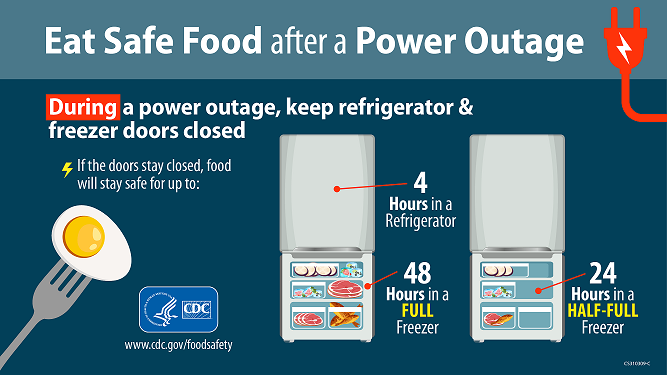
Food Safety during Power Outages
Food Safety and Power Outages at Home
- If the power is out for LESS THAN 2 HOURS, the food in your refrigerator and freezer will be safe to eat. While the power is out keep the refrigerator and freezer doors closed as much as possible. This will help to keep the food colder for longer.
- If the power is out for MORE THAN 2 HOURS , follow the guidelines below:
- For the Freezer section: A freezer that is half full will hold food safely for up to 24 hours. A full freezer will hold food safely for 48 hours. Do not open the freezer door if you can avoid it.
- For the Refrigerated section: Pack milk, other dairy products, meat, fish, eggs, gravy, and spoilable leftovers into a cooler surrounded by ice. Inexpensive Styrofoam coolers are fine for this purpose.
- Discard any perishable food (such as meat, poultry, fish, eggs or leftovers) that has been above 40°F for two hours or more. A full list of foods can be found on the USDA website.
IF IN DOUBT, THROW IT OUT!
- Fight cross-contamination, which is the transfer of harmful bacteria to food from other foods, cutting boards or utensils. Never place any type of food on a plate that previously held raw meat, poultry or seafood.
- Cooking can be more difficult during a power outage. Remember to thoroughly cook foods to avoid food borne illness:
- If you have one, use a meat thermometer to ensure that food reaches a safe internal temperature. Chicken should be cooked to at least 165F, Ground Meat (such as burgers) to 155F and fish to 145F.
General Advice
Always wash your hands with soap and water that has been boiled and cooled or disinfected. Hand washing is critical in emergencies to prevent illness..
For more information on emergency supplies, refer to the CDC Emergency response website.
Guidance for Food Establishments
If you do not have electrical power at your food establishment, you must cease all food operations and close until power is restored. You must remain closed until normal power is restored or until you can switch over to generator power. A Health Department inspection may be required before you reopen if power was lost for more than 2 hours. Call 703.746.4910.
Food Safety after a Power Outage
- Perishable, refrigerated foods such as meats, fish, poultry, and all dairy products that have been without refrigeration and have been above 41ºF for more than 2 hours should be discarded.
- Any perishable food from the freezer that has thawed for more than 2 hours and is above 41ºF should be discarded.
- Any food item discarded should be disposed of in well tied double‐bagged plastic garbage bags.
- After the power returns, it is OK to refreeze frozen foods that still contain ice crystals and are below 41ºF. This includes meats, fish, vegetables and cheeses.
- As a general rule, a well‐functioning freezer that remains unopened and is at least half full will keep foods cold for about 24 hours.
Food Safety after a Flood
Flood water can make foods unsafe to eat, especially if packaging is contaminated. Discard food if water has covered, splashed, dripped on or seeped into the package. This includes:
- Foods in packages made from paper, plastic, cloth, fiber or cardboard and glass jars.
- Foods, liquids or beverages in crown‐capped bottles or containers with pull‐tab tops, corks or screw caps; and
- Cans that:
- Are dented, leaking, bulging or rusted; and
- Have been tossed about and are far from their normal storage spot (possibility of pinholes or seam fractures).
- Cans may not be sold without all required labeling information. Therefore, cans with damaged labels should be discarded.
Any food item discarded should be disposed of in well tied double‐bagged plastic garbage bags.
Clean‐up after a Flood
- To prevent mold and mildew growth, conduct corrective actions within 24‐48 hours after the flood waters recede.
- Remove any standing water. Remove wet materials. Dispose of any materials that cannot be effectively cleaned and sanitized.
- Floors, walls, furnishings, carpets, and equipment damaged beyond salvage must be removed and replaced as necessary.
- Use a detergent solution to clean floors, equipment, and other affected areas followed by a clean water rinse.
- Disinfect the floor and any other affected areas by using an EPA‐registered disinfectant such as a 500 parts per million chlorine solution or other product labeled as a disinfectant. Follow manufacturer’s instructions for ‘disinfectant’ use.
- Air‐dry the affected area.
- Clean and sanitize any utensils and salvageable equipment in the affected area.
- Launder any linens or uniforms in contact with flood water. Launder separately from other linens by using bleach and/or a mechanical dryer.
- Launder or discard mop heads and other cleaning aids that contacted flood water.
- Alternative measure: Hire an outside service that has expertise in cleaning and sanitizing food establishments exposed to floods.
Other Useful Websites
Flooding Information : Alexandria’s low elevation and its proximity to the Potomac River make it susceptible to flooding. City residents should plan for flooding as part of their emergency preparedness planning.
After Storm Cleanup : Strong wind storms can leave behind downed trees and debris throughout the City. Find out how to clean up after a windy storm.
Food & Water Concerns : Recommendations for keeping water and food safe during a disaster.
A Guide for Consumers : proper food and water safety precautions in the event of flooding and/or power outages.
Protect Yourself from Animal and Insect Related Hazards After a Natural Disaster